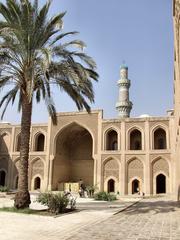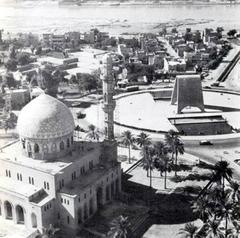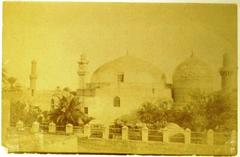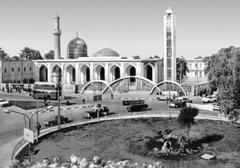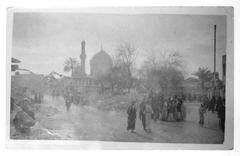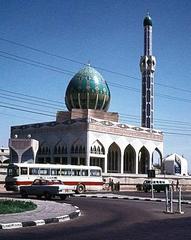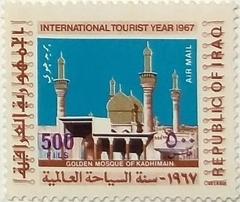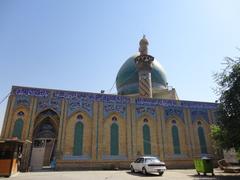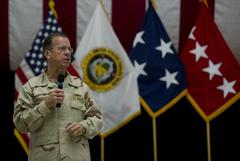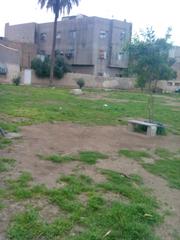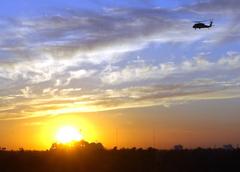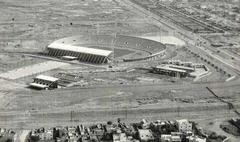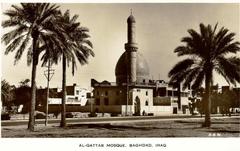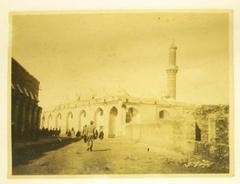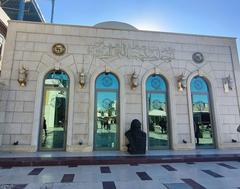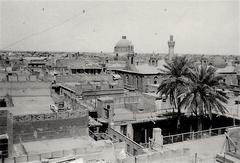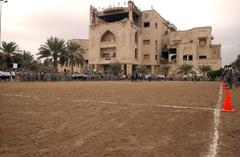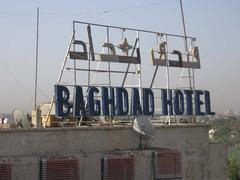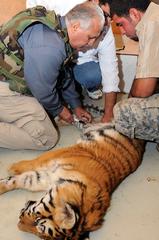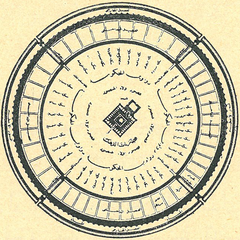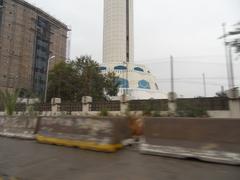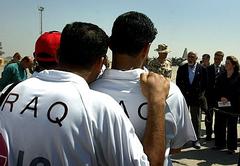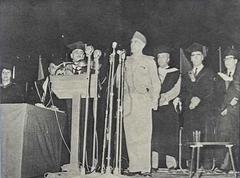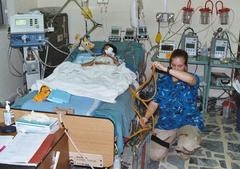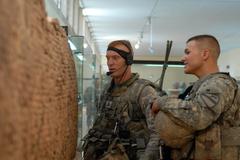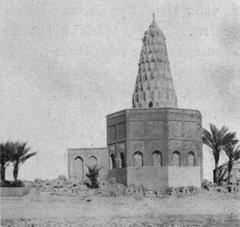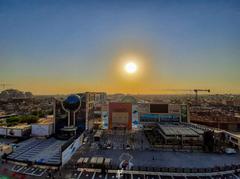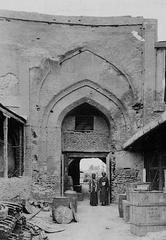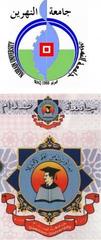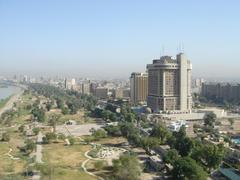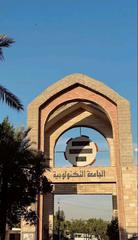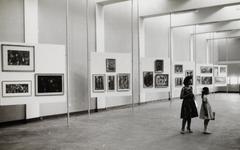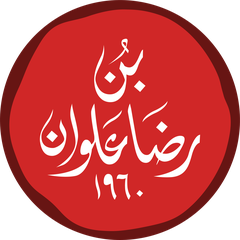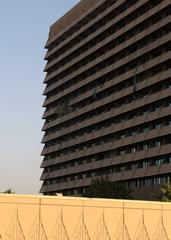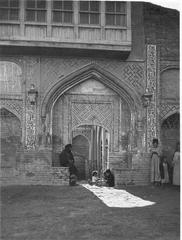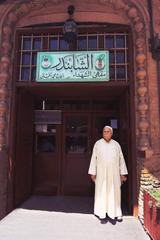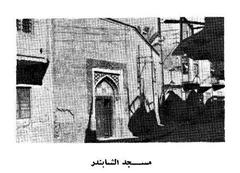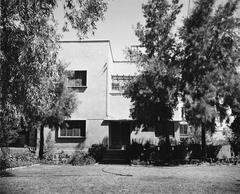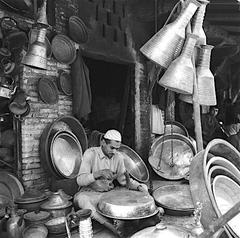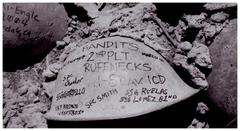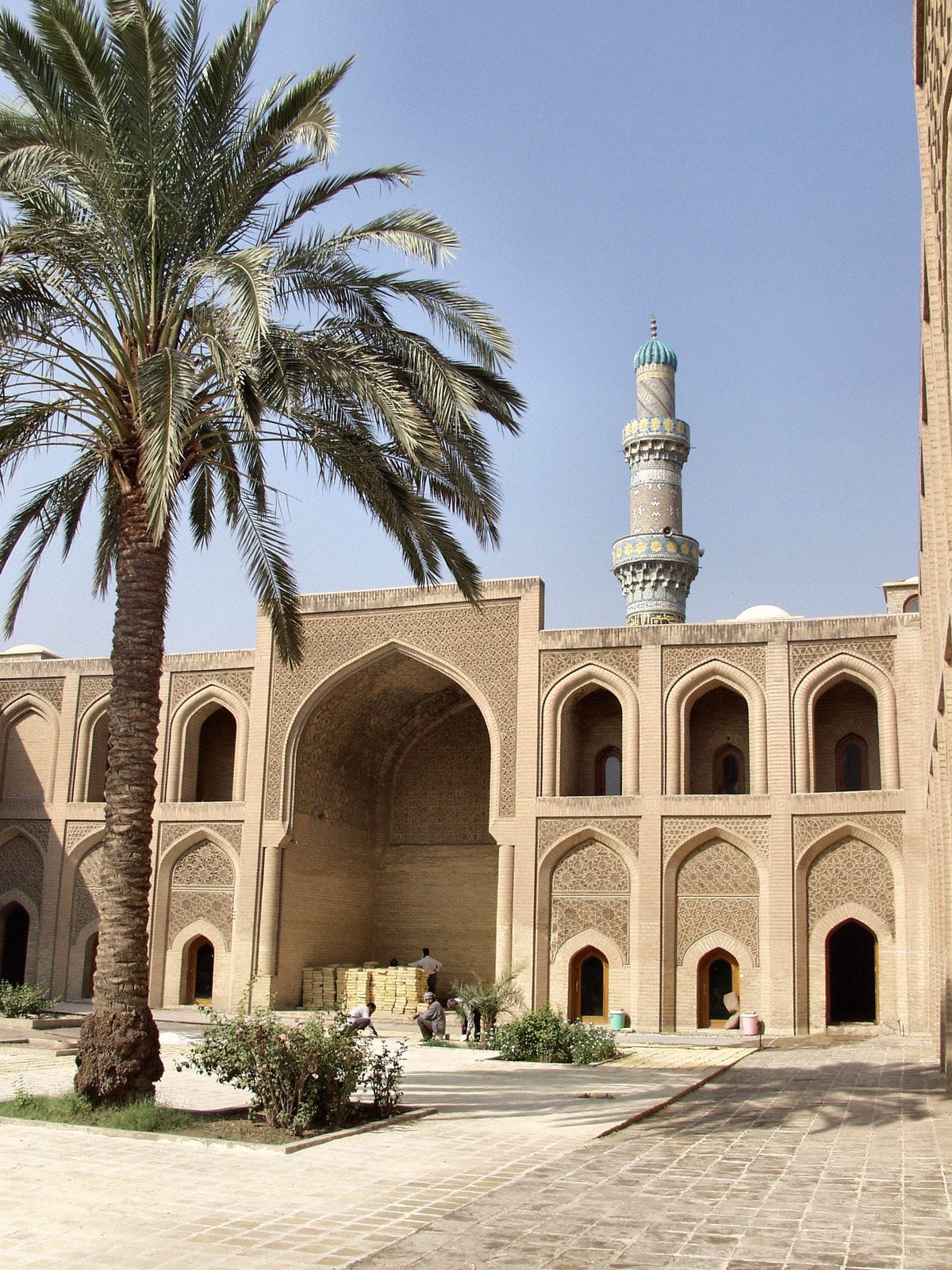
अल-मुस्तानसिरिया विश्वविद्यालय, बगदाद, इराक के दौरे के लिए एक व्यापक गाइड
दिनांक: 14/06/2025
परिचय
अल-मुस्तानसिरिया विश्वविद्यालय बगदाद की समृद्ध बौद्धिक और सांस्कृतिक विरासत का एक चमकता हुआ प्रतीक है। 13वीं शताब्दी की शुरुआत में अब्बासिद खलीफा अल-मुस्तानसिर बिल्लाह द्वारा अल-मुस्तानसिरिया मदरसे के रूप में स्थापित, यह इराक की राजधानी में इस्लामी शिक्षा, वास्तुशिल्प चमत्कार और सांस्कृतिक लचीलेपन का एक प्रकाश स्तंभ बना हुआ है। टाइग्रिस नदी के पूर्वी तट पर स्थित, यह विश्वविद्यालय सदियों की शैक्षिक नवाचार और अस्तित्व को एक साथ बुनता है, जो आगंतुकों को बगदाद की ऐतिहासिक और विद्वत्तापूर्ण परंपरा के केंद्र में एक दुर्लभ अंतर्दृष्टि प्रदान करता है (स्मिथसोनियन मैगज़ीन; माईप्लूरलिस्ट; राउंड सिटी).
यह गाइड अल-मुस्तानसिरिया विश्वविद्यालय का एक व्यापक अवलोकन प्रदान करता है, जिसमें इसके इतिहास, वास्तुशिल्प और शैक्षिक महत्व, विस्तृत आगंतुक जानकारी और आस-पास के बगदाद ऐतिहासिक स्थलों का पता लगाने के लिए सुझाव शामिल हैं।
ऐतिहासिक नींव और महत्व
स्थापना और अब्बासिद युग
अल-मुस्तानसिरिया मदरसा 1227 और 1234 ईस्वी के बीच खलीफा अल-मुस्तानसिर बिल्लाह द्वारा इस्लामी स्वर्ण युग के चरम पर स्थापित किया गया था। इसे सीखने के एक अग्रणी संस्थान के रूप में डिजाइन किया गया था जिसने चार प्रमुख सुन्नी कानूनी स्कूलों - हनबली, हनफी, शफी, और मलकी - को सीखने के एक ही केंद्र में एकीकृत किया, साथ ही चिकित्सा, गणित, खगोल विज्ञान और साहित्य में अध्ययन को बढ़ावा दिया (विकिपीडिया; राउंड सिटी). रुसाफा जिले में मदरसे का रणनीतिक स्थान बगदाद को बौद्धिक आदान-प्रदान के लिए एक वैश्विक केंद्र के रूप में स्थापित करता है।
वास्तुशिल्प और शैक्षिक कौशल
मदरसा अपनी अब्बासिद-युग की वास्तुकला के लिए प्रसिद्ध है, जो जटिल ईंट-काम, ज्यामितीय टाइल डिजाइन और सुलेख शिलालेखों की विशेषता वाले भव्य प्रवेश द्वार द्वारा पहचानी जाती है। इसके सबसे उल्लेखनीय नवाचारों में से एक पानी से चलने वाली घड़ी थी जिसका उपयोग प्रार्थना और कक्षा के समय को चिह्नित करने के लिए किया जाता था, जो मध्ययुगीन बगदाद की वैज्ञानिक प्रतिभा को दर्शाता है (माईप्लूरलिस्ट). परिसर में विशाल व्याख्यान कक्ष, दुर्लभ पांडुलिपियों से भरी पुस्तकालय और इस्लामी दुनिया भर के छात्रों और विद्वानों के लिए आवासीय क्वार्टर थे।
उत्तरजीविता और अनुकूलन
1258 के मंगोल आक्रमण और बाद में तुर्क और ब्रिटिश नियंत्रण की अवधि से बचने के बावजूद, अल-मुस्तानसिरिया की मुख्य संरचना विभिन्न कार्यों के लिए अनुकूलित होकर जीवित रही, जिसमें सीमा शुल्क कार्यालय, अस्पताल और सैन्य बैरक के रूप में उपयोग शामिल था (स्मिथसोनियन मैगज़ीन; इंड्रोयसी). 20वीं सदी से बहाली के प्रयासों ने इसकी मूल विशेषताओं को संरक्षित करने पर ध्यान केंद्रित किया है, हालांकि संघर्ष और बजट की कमी जैसी चुनौतियों ने कभी-कभी प्रगति को रोक दिया है।
आधुनिक विश्वविद्यालय: विरासत और विस्तार
1963 में एक आधुनिक विश्वविद्यालय के रूप में पुन: स्थापित, अल-मुस्तानसिरिया आज चिकित्सा, इंजीनियरिंग, कानून और मानविकी सहित विषयों में 13 कॉलेजों का गठन करता है (टॉप यूनिवर्सिटीज; विज़िट इराक नाउ). यह इराक के अग्रणी शैक्षणिक संस्थानों में से एक है, जो अनुसंधान, नवाचार और अंतर्राष्ट्रीय सहयोग का समर्थन करता है। विश्वविद्यालय का स्थायी मिशन पारंपरिक इस्लामी छात्रवृत्ति को समकालीन शिक्षा और सामाजिक आवश्यकताओं के साथ संतुलित करना है।
अल-मुस्तानसिरिया विश्वविद्यालय का दौरा: व्यावहारिक जानकारी
स्थान और वहाँ पहुँचना
- पता: रुसाफा जिला, मध्य बगदाद, टाइग्रिस नदी के पूर्वी तट के साथ।
- पहुँच: टैक्सी (सुविधा और सुरक्षा के लिए अनुशंसित), सार्वजनिक परिवहन, या मुतनाब्बी स्ट्रीट और कॉपर मार्केट जैसे आस-पास के स्थलों से पैदल चलकर पहुँचा जा सकता है (रॉकी रोड ट्रैवल).
आगंतुक घंटे और टिकट
- घंटे: आम तौर पर शनिवार से गुरुवार, सुबह 9:00 बजे से शाम 5:00 बजे तक खुला रहता है। कुछ स्रोत सोमवार से शुक्रवार, सुबह 9:00 बजे से दोपहर 4:00 बजे तक इंगित करते हैं। अपडेट या छुट्टी बंद होने के लिए स्थानीय रूप से जाँच करें।
- प्रवेश: परिसर में प्रवेश आम तौर पर निःशुल्क होता है; ऐतिहासिक मदरसा परिसर के लिए एक छोटा सा शुल्क (लगभग 5,000 आईक्यूडी / ~$3.50 अमरीकी डालर) लिया जा सकता है, खासकर निर्देशित पर्यटन या विशेष प्रदर्शनियों के लिए (वाइल्ड ट्रिप्स).
- निर्देशित पर्यटन: गहरी अंतर्दृष्टि के लिए अंग्रेजी बोलने वाले गाइड की सिफारिश की जाती है, जो ऑन-साइट या स्थानीय एजेंसियों के माध्यम से उपलब्ध हैं (ट्रैवल2इराक).
सुलभता और सुविधाएं
- गतिशीलता: मुख्य आंगन और भूतल के हॉल व्हीलचेयर सुलभ हैं, लेकिन सीढ़ियों और असमान सतहों के कारण ऊपरी स्तरों और ऐतिहासिक वर्गों में सीमाएं हो सकती हैं।
- शौचालय: प्रवेश द्वार के पास बुनियादी सुविधाएं उपलब्ध हैं।
- भोजन और पेय: पानी और स्नैक्स लाएँ। ऑन-साइट कैफे नहीं हैं; बाहर के विक्रेता जलपान बेचते हैं।
- सुरक्षा: प्रवेश द्वार पर सुरक्षा जाँच की अपेक्षा करें। वैध आईडी साथ रखें।
पोशाक कोड और आगंतुक शिष्टाचार
- पोशाक: मामूली पोशाक आवश्यक है - सभी के लिए लंबी पैंट / स्कर्ट, ढके हुए कंधे; महिलाओं को धार्मिक / ऐतिहासिक क्षेत्रों के लिए हेडस्कार्फ लाना चाहिए।
- जूते: प्रार्थना स्थलों में प्रवेश करने से पहले जूते उतारें।
- फोटोग्राफी: अधिकांश क्षेत्रों में अनुमति है; संग्रहालय में फ्लैश से बचें और लोगों की तस्वीरें लेने से पहले हमेशा पूछें।
आगंतुक अनुभव की मुख्य बातें
वास्तुकला और वातावरण
सुंदर संरक्षित अब्बासिद वास्तुकला का अन्वेषण करें - मेहराबदार द्वार, मोज़ेक-टाइल वाले हॉल, हरे-भरे आंगन, और सुलेख पैनल (लॉरे वांडर्स). विशेष रूप से सुबह जल्दी या देर शाम को शांत वातावरण, चिंतन और फोटोग्राफी को आमंत्रित करता है।
संग्रहालय और प्रदर्शनियाँ
ऑन-साइट संग्रहालय पांडुलिपियों, वैज्ञानिक उपकरणों और बहाल वास्तुकला के टुकड़ों को प्रदर्शित करता है, जो बगदाद के विद्वत्तापूर्ण शिखर का एक झलक प्रदान करता है (वाइल्ड ट्रिप्स).
सांस्कृतिक सहभागिता
आगंतुक अक्सर स्थानीय छात्रों और विद्वानों के साथ बातचीत करते हैं, कभी-कभी सार्वजनिक व्याख्यानों में भाग लेते हैं, और विशेष आयोजनों के दौरान, पारंपरिक संगीत या कला प्रदर्शन देखते हैं (एक्सप्लोरसिटी.लाइफ).
आस-पास के बगदाद ऐतिहासिक स्थल
- मुतनाब्बी स्ट्रीट: प्रसिद्ध पुस्तक बाजार और साहित्यिक क्वार्टर, यात्रा के बाद टहलने के लिए आदर्श (लॉरे वांडर्स).
- कॉपर मार्केट: पारंपरिक हस्तशिल्प और स्मृति चिन्ह।
- इराक का राष्ट्रीय संग्रहालय: अमूल्य मेसोपोटामियाई कलाकृतियाँ रखता है।
- मुस्तानसिरिया ब्रिज और अल-कज़ीमिया मस्जिद: आसान पहुंच के भीतर महत्वपूर्ण धार्मिक और वास्तुशिल्प स्थल (रॉकी रोड ट्रैवल).
सुरक्षा, यात्रा सुझाव और जाने का सबसे अच्छा समय
- सुरक्षा: बगदाद की सुरक्षा में सुधार हुआ है, जिसमें विश्वविद्यालय क्षेत्रों को आगंतुकों के लिए सुरक्षित माना जाता है। राजनीतिक सभाओं से बचें, स्थानीय मार्गदर्शन का पालन करें, और यात्रा सलाह की जाँच करें (एडवेंचर्स ऑफ लिल निकी).
- सर्वोत्तम मौसम: वसंत (मार्च-मई) और पतझड़ (अक्टूबर-नवंबर) में हल्का मौसम होता है; अत्यधिक गर्मी से बचें।
- महिला यात्री: रूढ़िवादी पोशाक पहनें और निर्देशित समूहों में शामिल होने पर विचार करें (फेयरवेल अलार्म्स).
- भाषा: अरबी प्राथमिक है; सीमित अंग्रेजी बोली जाती है - अनुवाद ऐप या बुनियादी अरबी वाक्यांश सहायक होते हैं।
अक्सर पूछे जाने वाले प्रश्न (FAQ)
प्रश्न: अल-मुस्तानसिरिया विश्वविद्यालय के लिए आगंतुक घंटे क्या हैं? A: आम तौर पर सुबह 9:00 बजे से शाम 5:00 बजे तक (शनिवार-गुरुवार); घंटे छुट्टियों पर भिन्न हो सकते हैं।
प्रश्न: क्या प्रवेश शुल्क है? A: परिसर में प्रवेश आम तौर पर निःशुल्क होता है; ऐतिहासिक मदरसा या निर्देशित पर्यटन के लिए एक छोटा सा शुल्क लागू हो सकता है।
प्रश्न: क्या निर्देशित पर्यटन उपलब्ध हैं? A: हाँ, अरबी और अंग्रेजी में उपलब्ध हैं, और संदर्भ और पहुंच के लिए अनुशंसित हैं।
प्रश्न: क्या साइट विकलांग लोगों के लिए सुलभ है? A: मुख्य क्षेत्र सुलभ हैं, लेकिन ऐतिहासिक वर्गों में सीढ़ियों और असमान सतहों के कारण सीमित पहुंच हो सकती है।
प्रश्न: क्या मैं तस्वीरें ले सकता हूँ? A: हाँ, लेकिन संग्रहालयों में फ्लैश से बचें और लोगों या प्रतिबंधित क्षेत्रों की तस्वीरें लेने से पहले हमेशा पूछें।
प्रश्न: आस-पास के आकर्षण क्या हैं? A: मुतनाब्बी स्ट्रीट, कॉपर मार्केट, इराक का राष्ट्रीय संग्रहालय, मुस्तानसिरिया ब्रिज और अल-कज़ीमिया मस्जिद।
अंतर्राष्ट्रीय आगंतुकों के लिए अवसर
अल-मुस्तानसिरिया विश्वविद्यालय इराक सरकार छात्रवृत्ति कार्यक्रम में भाग लेता है, जो विभिन्न शैक्षणिक स्तरों पर स्थानीय और अंतर्राष्ट्रीय छात्रों का स्वागत करता है (worldscholarshipnews.com). अनुसंधान या अकादमिक आदान-प्रदान में रुचि रखने वाले आगंतुकों को विश्वविद्यालय से पहले संपर्क करना चाहिए।
मुख्य संसाधन और आधिकारिक लिंक
- अल-मुस्तानसिरिया विश्वविद्यालय की आधिकारिक वेबसाइट (अरबी)
- इराक का पर्यटन मंत्रालय
- ऑडियोला ऐप - ऑडियो गाइड टूर और आगंतुक जानकारी के लिए
- बगदाद की सांस्कृतिक विरासत का गाइड
- इराक के शीर्ष पर्यटक आकर्षण
सारांश और कॉल टू एक्शन
अल-मुस्तानसिरिया विश्वविद्यालय बगदाद की सीखने, संस्कृति और लचीलेपन के केंद्र के रूप में अपनी विरासत का एक जीवंत प्रमाण बना हुआ है। इसका ऐतिहासिक मदरसा परिसर, क्यूरेटेड प्रदर्शनियाँ, और जीवंत अकादमिक जीवंतता आगंतुकों को इराक की राजधानी की वास्तुशिल्प भव्यता और बौद्धिक विरासत का अनुभव करने के लिए आमंत्रित करती है (studyatuniversity.com; टॉप यूनिवर्सिटीज; वाइल्ड ट्रिप्स). जैसे ही आप अपनी यात्रा की योजना बनाते हैं, ऑडियो गाइड टूर, वास्तविक समय अपडेट और यात्रा सहायता के लिए ऑडियोला ऐप डाउनलोड करें। इराक के अद्वितीय सांस्कृतिक खजाने का पता लगाने के लिए अधिक जानकारी और प्रेरणा के लिए हमें सोशल मीडिया पर फॉलो करें।
स्रोत
- स्मिथसोनियन मैगज़ीन
- अल-मुस्तानसिरिया विश्वविद्यालय - विकिपीडिया
- अल-मदरसा अल-मुस्तानसिरिया के अंदर - राउंड सिटी
- मुस्तानसिरिया विश्वविद्यालय - माईप्लूरलिस्ट
- अल-मुस्तानसिरिया मदरसा बगदाद - इंड्रोयसी
- इराक में मुस्तानसिरिया विश्वविद्यालय - अध्ययन विश्वविद्यालय
- बगदाद यात्रा गाइड - रॉकी रोड ट्रैवल
- बगदाद - करने के लिए चीजें - लॉरे वांडर्स
- बगदाद में शीर्ष 10 पर्यटक आकर्षण - वाइल्ड ट्रिप्स
- मुस्तानसिरिया विश्वविद्यालय के लिए शीर्ष विश्वविद्यालय रैंकिंग
- इराक सरकारी छात्रवृत्ति - विश्व छात्रवृत्ति समाचार
- ऑडियोला मोबाइल ऐप
ऑडियोला2024{‘date’: ‘14/06/2025’, ‘task’: {‘model’: ‘gpt-4.1-mini’, ‘query’: ‘Comprehensive guide to visiting Al-Mustansiriya University, Baghdad, Iraq: history, significance, visitor tips, and everything tourists need to know for a memorable experience.’, ‘verbose’: False, ‘guidelines’: [“Keyword Research: Identify relevant keywords that potential visitors are likely to search for, such as ‘[Monument Name] visiting hours,’ ‘[Monument Name] tickets,’ and ‘[City] historical sites.’ Use these keywords strategically throughout the article, including in the title, headers, and body text, but avoid keyword stuffing.”, ‘Engaging and Informative Title: Craft a title that is both SEO-friendly and compelling to encourage clicks. Include the main keyword and make it clear what the article will cover.’, ‘Structured Content: Use headings (H1, H2, H3) to organize the content effectively. This helps with SEO and makes the article easier for readers to navigate. Include an introduction that hooks the reader, a detailed body that covers all relevant aspects, and a conclusion that summarizes the key points.’, ‘Comprehensive Coverage: Address common questions and topics of interest such as the history of the monument, its cultural significance, visitor information (e.g., ticket prices, opening hours), travel tips, nearby attractions, and accessibility. Include sections that might be unique to the monument, like special events, guided tours, and photographic spots.’, ‘Quality Content: Ensure the content is well-researched, accurate, and provides real value to readers. Use reliable sources and provide factual information. Write in a clear, engaging, and accessible style. Consider your audience and use language that is appropriate for those likely to visit the monument.’, ‘Visuals and Media: Incorporate high-quality images or videos of the monument. These should be optimized for the web (correct sizing, alt tags with keywords). Consider interactive elements like virtual tours or maps.’, ‘Internal and External Links: Include links to other related articles on your site to encourage deeper engagement (internal links). Link to official websites for the monument or credible sources for further reading (external links).’, ‘FAQ: Incorporate FAQ sections to target voice search queries and featured snippets’, ‘Visit and Stay Up to Date: End the article with a call to action, such as encouraging readers to download our mobile app Audiala, check out other related posts, or follow on social media for more updates.’], ‘max_sections’: 4, ‘publish_formats’: {‘pdf’: False, ‘docx’: False, ‘markdown’: True}, ‘follow_guidelines’: True}, ‘title’: ‘A Comprehensive Guide to Visiting Al-Mustansiriya University, Baghdad, Iraq’, ‘report’: ”# Al-Mustansiriya University Visiting Hours, Tickets, and Baghdad Historical Sites Guide\n\n#### Date: 14/06/2025\n\n## Introduction\n\nAl-Mustansiriya University is a shining emblem of Baghdad’s rich intellectual and cultural legacy. Established in the early 13th century as the Al-Mustansiriya Madrasah by Abbasid Caliph Al-Mustansir Billah, it remains a beacon of Islamic education, architectural marvel, and cultural resilience in Iraq’s capital. Located on the eastern bank of the Tigris River, the university weaves together centuries of educational innovation and survival, offering visitors a rare insight into the heart of Baghdad’s historical and scholarly tradition (Smithsonian Magazine; MyPluralist; Round City).\n\nThis guide provides a comprehensive overview of Al-Mustansiriya University, including its history, architectural and educational significance, detailed visitor information, and tips for exploring nearby Baghdad historical sites.\n\n---\n\n## Historical Foundations and Significance\n\n### Foundation and Abbasid Era\n\nAl-Mustansiriya Madrasah was founded between 1227 and 1234 CE by Caliph Al-Mustansir Billah at the height of the Islamic Golden Age. It was designed as a pioneering institution that unified the four major Sunni legal schools—Hanbali, Hanafi, Shafi’i, and Maliki—into a single center of learning, while also advancing studies in medicine, mathematics, astronomy, and literature (Wikipedia; Round City). The madrasah’s strategic location in the Rusafa district established Baghdad as a global hub for intellectual exchange.\n\n### Architectural and Educational Prowess\n\nThe madrasah is renowned for its Abbasid-era architecture, characterized by intricate brickwork, geometric tile designs, and a grand entrance gate featuring calligraphic inscriptions. One of its most remarkable innovations was a water-powered clock used to mark prayer and class times, reflecting the scientific ingenuity of medieval Baghdad (MyPluralist). The complex housed expansive lecture halls, libraries brimming with rare manuscripts, and residential quarters for students and scholars from across the Islamic world.\n\n### Survival and Adaptation\n\nDespite enduring the Mongol invasion of 1258 and subsequent periods of Ottoman and British control, the core structure of Al-Mustansiriya survived by adapting to various functions, including use as a customs office, hospital, and military barracks (Smithsonian Magazine; Indroyc). Restoration efforts since the 20th century have focused on preserving its original features, though challenges such as conflict and budget shortfalls have sometimes stalled progress.\n\n---\n\n## The Modern University: Legacy and Expansion\n\nRe-established as a modern university in 1963, Al-Mustansiriya today comprises 13 colleges across disciplines including medicine, engineering, law, and humanities (Top Universities; Visit Iraq Now). It ranks among Iraq’s leading academic institutions, supporting research, innovation, and international collaborations. The university’s enduring mission is to balance traditional Islamic scholarship with contemporary education and societal needs.\n\n---\n\n## Visiting Al-Mustansiriya University: Practical Information\n\n### Location and Getting There\n\n- Address: Rusafa district, central Baghdad, along the eastern bank of the Tigris River.\n- Access: Reachable by taxi (recommended for convenience and safety), public transport, or on foot from nearby sites such as Mutanabbi Street and the Copper Market (Rocky Road Travel).\n\n### Visiting Hours and Tickets\n\n- Hours: Generally open Saturday through Thursday, 9:00 AM to 5:00 PM. Some sources indicate Monday to Friday, 9:00 AM to 4:00 PM. Check locally for updates or holiday closures.\n- Admission: Entry to the campus is usually free; the historic madrasah complex may charge a small fee (approx. 5,000 IQD/$3.50 USD), especially for guided tours or special exhibitions (Wild Trips).\n- Guided Tours: Available on-site or via local agencies, with English-speaking guides recommended for deeper insight (Travel2Iraq).\n\n### Accessibility and Facilities\n\n- Mobility: The main courtyard and ground-floor halls are wheelchair accessible, but upper levels and historic sections may have limitations due to stairs and uneven surfaces.\n- Restrooms: Basic facilities are available near the entrance.\n- Food and Drink: Bring water and snacks. No on-site cafés; vendors outside sell refreshments.\n- Security: Expect security checks at entrances. Carry valid ID.\n\n### Dress Code and Visitor Etiquette\n\n- Attire: Modest dress is required—long trousers/skirts, covered shoulders for all; women should bring a headscarf for religious/historic areas.\n- Shoes: Remove shoes before entering prayer spaces.\n- Photography: Allowed in most areas; avoid flash in the museum and always ask before photographing people.\n\n---\n\n## Highlights of the Visitor Experience\n\n### Architecture and Ambience\n\nExplore beautifully preserved Abbasid architecture—arched gateways, mosaic-tiled halls, lush courtyards, and calligraphic panels (Laure Wanders). The serene atmosphere, especially in the early morning or late afternoon, invites reflection and photography.\n\n### Museum and Exhibits\n\nThe on-site museum displays historic manuscripts, scientific instruments, and restored architectural fragments, offering a glimpse into Baghdad’s scholarly zenith (Wild Trips).\n\n### Cultural Engagement\n\nVisitors often interact with local students and scholars, attend occasional public lectures, and, during special events, witness traditional music or art exhibitions (explorecity.life).\n\n---\n\n## Nearby Baghdad Historical Sites\n\n- Mutanabbi Street: Renowned book market and literary quarter, ideal for a post-visit stroll (Laure Wanders).\n- Copper Market: Traditional handicrafts and souvenirs.\n- National Museum of Iraq: Houses invaluable Mesopotamian artifacts.\n- Mustansiriya Bridge and Al-Kadhimiya Mosque: Important religious and architectural sites within easy reach (Rocky Road Travel).\n\n---\n\n## Safety, Travel Tips, and Best Times to Visit\n\n- Safety: Baghdad’s security has improved, with university areas considered safe for visitors. Avoid political gatherings, follow local guidance, and check travel advisories (Adventures of Lil Nicki).\n- Best Seasons: Spring (March–May) and autumn (October–November) offer mild weather; avoid peak summer heat.\n- Female Travelers: Dress conservatively and consider joining guided groups (Farewell Alarms).\n- Language: Arabic is primary; limited English spoken—translation apps or basic Arabic phrases are helpful.\n\n---\n\n## Frequently Asked Questions (FAQs)\n\nQ: What are the visiting hours for Al-Mustansiriya University? \nA: Typically 9:00 AM–5:00 PM (Saturday–Thursday); hours may vary on holidays.\n\nQ: Is there an entrance fee? \nA: Campus entry is usually free; a small fee may apply for the historic madrasah or guided tours.\n\nQ: Are guided tours available? \nA: Yes, in Arabic and English, and are recommended for context and access.\n\nQ: Is the site accessible for people with disabilities? \nA: Main areas are accessible, but historic sections may have limited access.\n\nQ: Can I take photos? \nA: Yes, but avoid flash in museums and always ask before photographing people or restricted areas.\n\nQ: What are nearby attractions? \nA: Mutanabbi Street, Copper Market, National Museum of Iraq, Mustansiriya Bridge, and Al-Kadhimiya Mosque.\n\n---\n\n## Opportunities for International Visitors\n\nAl-Mustansiriya University participates in the Iraq Government Scholarship program, welcoming local and international students at various academic levels (worldscholarshipnews.com). Visitors interested in research or academic exchange should contact the university in advance.\n\n---\n\n## Key Resources and Official Links\n\n- Official Al-Mustansiriya University Website (Arabic)\n- Iraqi Ministry of Tourism\n- Audiala App – For guided audio tours and up-to-date visitor info\n- Guide to Baghdad’s Cultural Heritage\n- Top Iraqi Tourist Attractions\n\n---\n\n## Summary & Call to Action\n\nAl-Mustansiriya University remains a living testament to Baghdad’s legacy as a center of learning, culture, and resilience. Its historic madrasah complex, curated exhibits, and ongoing academic vibrancy invite visitors to experience the architectural splendors and intellectual heritage of Iraq’s capital (studyatuniversity.com; Top Universities; Wild Trips). As you plan your journey, download the Audiala app for audio-guided tours, real-time updates, and travel support. Follow us on social media for more information and inspiration to explore Iraq’s unparalleled cultural treasures.\n\n---\n\n## Sources\n\n- What Restoration of Iraq’s Oldest University Says About Iraq’s Future – Smithsonian Magazine\n- Al-Mustansiriya University – Wikipedia\n- Inside Al-Madrasah Al-Mustansiriya – Round City\n- Mustansiriya University – MyPluralist\n- Al-Mustansiriyya Madrasa Baghdad – Indroyc\n- Mustansiriyah University in Iraq – Study at University\n- Baghdad Travel Guide – Rocky Road Travel\n- Baghdad – Things to Do – Laure Wanders\n- Top 10 Tourist Attractions in Baghdad – Wild Trips\n- Top Universities Ranking for Mustansiriyah University\n- Iraq Government Scholarships – World Scholarship News\n- Audiala Mobile App\n\n”, ‘headers’: {‘date’: ‘Date’, ‘title’: ‘Al-Mustansiriya University Visiting Hours Tickets and Baghdad Historical Sites Guide’, ‘conclusion’: ‘Summary of key points and call to action to download Audiala app and follow for updates’, ‘references’: ‘Reliable sources official websites and further reading links’, ‘introduction’: ‘Introduction to Al-Mustansiriya University and its significance in Baghdad history’, ‘table_of_contents’: ‘Contents including visiting hours tickets history cultural significance travel tips nearby attractions and FAQs’}, ‘sources’: [”- What Restoration of Iraq’s Oldest University Says About Iraq’s Future, 2020, Smithsonian Magazine https://www.smithsonianmag.com/history/what-restoration-iraqs-oldest-university-says-about-iraqs-future-180973039/”, ’- Al-Mustansiriya University, 2024, Wikipedia https://en.wikipedia.org/wiki/Al-Mustansiriya_University’, ’- Inside Al-Madrasah Al-Mustansiriya: A Medieval Abbasid Era Gem in the Heart of Baghdad, 2019, Round City https://round-city.com/inside-al-madrasah-al-mustansiriya-a-medieval-abbasid-era-gem-in-the-heart-of-baghdad/’, ’- Mustansiriya University, 2023, MyPluralist https://mypluralist.com/2023/03/06/mustansiriya-university/’, ’- Al-Mustansiriyya Madrasa Baghdad, 2019, Indroyc https://indroyc.com/2019/05/03/al-mustansiriyya-madrasa-baghdad/’, ’- Mustansiriyah University in Iraq, 2024, Study at University https://studyatuniversity.com/universities/mustansiriyah-university-in-iraq/’, ’- Baghdad Travel Guide, 2023, Rocky Road Travel https://rockyroadtravel.com/baghdad-travel-guide/’, ’- Baghdad – Things to Do, 2024, Laure Wanders https://www.laurewanders.com/things-to-do-in-baghdad/’, ’- Top 10 Tourist Attractions in Baghdad, 2023, Wild Trips https://www.wildtrips.net/visit/Baghdad-Iraq-top-10-attractions-to-visit.htm’, ’- Top Universities Ranking for Mustansiriyah University, 2024, Top Universities https://www.topuniversities.com/universities/mustansiriyah-university’, ’- Iraq Government Scholarships, 2023, World Scholarship News https://worldscholarshipnews.com/iraq-government-scholarships/’, ’- Audiala Mobile App https://audiala.app’], ‘sections’: [‘Historical Overview’, ‘Cultural and Educational Significance’, ‘Visitor Experience’, ‘Practical Information for Visitors’], ‘conclusion’: ‘Al-Mustansiriya University remains a living testament to Baghdad’s historical prominence as a center of knowledge, culture, and intellectual exchange since its establishment in the 13th century. Its survival through centuries of conflict, including the devastating Mongol invasion and more recent political upheavals, underscores the resilience embedded in its architecture and institutional legacy (Smithsonian Magazine). Today, the university not only preserves the rich Abbasid-era architectural and scholarly traditions but also functions as a modern academic powerhouse contributing to Iraq’s educational and societal development (studyatuniversity.com; Top Universities).\n\nFor visitors, the university offers an unparalleled glimpse into medieval Islamic education through its historic madrasah complex, curated museum exhibits, and vibrant cultural events, all accessible with practical visitor information such as opening hours, guided tours, and local travel tips (Wild Trips; explorecity.life). The site’s proximity to other Baghdad landmarks like the Mustansiriya Bridge, Al-Kadhimiya Mosque, Mutanabbi Street, and the National Museum enriches the visitor experience, providing a comprehensive cultural itinerary within Iraq’s capital (Rocky Road Travel).\n\nAs Iraq continues to rebuild and promote its cultural heritage, Al-Mustansiriya University stands as a symbol of endurance, adaptation, and renewal. Travelers and scholars alike are encouraged to explore this historic site, engage with its academic community, and support ongoing preservation efforts. To enhance your visit, consider downloading the Audiala app for audio tours and up-to-date information, and follow official channels for the latest events and insights. Embarking on a journey to Al-Mustansiriya University is not only an exploration of a historic gem but also an immersion into the heart of Baghdad’s enduring legacy as a beacon of education and cultural identity (Audiala; MyPluralist).’, ‘introduction’: ‘Al-Mustansiriya University in Baghdad stands as a remarkable emblem of Iraq’s illustrious intellectual and cultural heritage, tracing its origins back to the 13th century during the zenith of the Islamic Golden Age. Established initially as the Al-Mustansiriya Madrasah by Abbasid Caliph Al-Mustansir Billah between 1227 and 1234 CE, it was conceived as a pioneering institution that brought together the four major Sunni Islamic jurisprudence schools, alongside a rich curriculum spanning theology, law, medicine, mathematics, astronomy, and literature (Smithsonian Magazine; MyPluralist). Situated strategically on the eastern bank of the Tigris River within Baghdad’s historic Rusafa district, the madrasah exemplifies the architectural ingenuity of the Abbasid era, featuring intricate terracotta brickwork, geometric patterns, and innovative features such as a water-powered clock marking prayer times (Round City).\n\nOver centuries, Al-Mustansiriya survived invasions, political shifts, and urban transformations, adapting its role from a medieval educational institution to a modern university founded in 1963 that today comprises multiple colleges dedicated to diverse academic disciplines (Wikipedia; Top Universities). Visitors to this historic site can immerse themselves in a rich cultural and educational journey — exploring beautifully preserved architecture, historic lecture halls, and manuscripts, while also engaging with the living academic community that continues to foster scholarship and cultural dialogue in Baghdad (explorecity.life; Wild Trips).\n\nWhether you are a history enthusiast, cultural traveler, or scholar, this comprehensive guide provides essential information on Al-Mustansiriya University visiting hours, ticketing, accessibility, tours, and nearby attractions to help you plan a safe and enriching visit while appreciating its enduring symbolism as a beacon of learning and resilience in Iraq’s capital (Rocky Road Travel; Indroyc).’, ‘research_data’: [{“Al-Mustansiriya University: Exploring Baghdad’s Historic Educational Gem and Visitor Guide”: ”## Introduction\n\nAl-Mustansiriya University in Baghdad is one of Iraq’s most iconic historical sites and a living symbol of the city’s rich intellectual heritage. Founded originally as the Al-Mustansiriya Madrasah in the 13th century, it stands as a testament to the Islamic Golden Age’s educational and architectural advancements. This article offers a comprehensive historical overview, practical visitor information including visiting hours and ticketing, and tips for exploring this remarkable Baghdad historical site.\n\n## Foundation and Early Abbasid Era\n\nAl-Mustansiriya University traces its origins to the Al-Mustansiriya Madrasah, established between 1227 and 1234 CE by the Abbasid Caliph Al-Mustansir Billah in Baghdad (Smithsonian Magazine; Wikipedia). This institution was conceived during the zenith of the Islamic Golden Age, a period when Baghdad was a global center of learning, culture, and scientific advancement. The madrasah was strategically located on the left bank of the Tigris River, in the heart of the Abbasid capital, and its construction was overseen by the engineer Muayad Al-Din Abu Talib Muhammad bin Al-Alqami (Round City).\n\nThe inauguration of the madrasah was a grand affair, attended by the caliph himself, reflecting its importance as a symbol of intellectual and religious authority. The institution was unique for its time, offering a comprehensive curriculum that included theology, law, medicine, mathematics, astronomy, and literature. It was also notable for housing all four major Sunni schools of Islamic jurisprudence—Hanbali, Hanafi, Shafi’i, and Maliki—under one roof, fostering an environment of scholarly pluralism (MyPluralist).\n\n## Architectural and Educational Significance\n\nThe original Al-Mustansiriya Madrasah is considered an architectural masterpiece of the Abbasid era. Its design incorporated sun-baked and kiln-fired mud bricks, with extensive use of geometric patterns, arabesque terracotta, and carved brickwork featuring vegetal motifs reminiscent of earlier Abbasid styles (Round City). The building featured iwans (vaulted halls), arched doorways, and a tapering gateway adorned with inscriptions and geometric themes. A remarkable feature was the water-powered clock at the entrance, which announced prayer and study times—a testament to the scientific ingenuity of the period (MyPluralist).\n\nThe madrasah’s library was among the richest in the medieval world, housing thousands of manuscripts on diverse subjects. Students and scholars traveled from as far as Yemen and Syria to study here, and the institution quickly gained a reputation as one of the world’s earliest universities (Smithsonian Magazine). The legendary Moroccan traveler Ibn Battuta visited in 1327 and described the scholarly atmosphere, noting the dignified presence of teachers and the rigorous academic environment.\n\n## Survival Through Turbulence\n\nAl-Mustansiriya’s resilience is remarkable, having survived centuries of upheaval that claimed most of Baghdad’s medieval heritage. The Mongol invasion of 1258, which devastated much of the city, left the madrasah standing, thanks in part to its sturdy, squat architecture and relatively inconspicuous location along the Tigris (Smithsonian Magazine). Over the centuries, the building adapted to various uses: it served as a barracks, customs office, and even a hospital during the Ottoman period (Indroyc). In the late 18th to early 20th centuries, it became a rest stop and storage facility for soldiers, and in 1865, the Ottomans converted it into a customs office.\n\nDespite these changes, the core structure endured, making it one of the few surviving monuments from Baghdad’s Abbasid era. The madrasah’s survival is often attributed to its robust construction and its ability to adapt to the needs of successive rulers, as well as its less prominent placement, which spared it from the urban renewal projects that erased much of old Baghdad during the British and Baathist periods (Smithsonian Magazine).\n\n## Modern Era and Restoration Efforts\n\nThe 20th century brought renewed attention to Al-Mustansiriya’s historical significance. In 1973, the Directorate of Antiquities in Iraq assumed oversight of the madrasah, initiating ongoing restoration projects to preserve its architectural and cultural legacy (Indroyc). Restoration efforts have included reconditioning the original sand-colored bricks from Karbala, repairing inscriptions, and stabilizing damaged walls. However, these projects have faced significant challenges, including war, political instability, and budget constraints. The rise of ISIS in 2014 forced foreign conservators to leave, and subsequent financial difficulties led to stalled or incomplete restoration work (Smithsonian Magazine; MyPluralist).\n\nThe madrasah’s heritage has also been subject to political machinations, with debates over its association with the Sunni Abbasids affecting the level of official support for its preservation. Despite these obstacles, local pride in the monument remains strong, and it continues to be a symbol of Baghdad’s enduring cultural identity (Smithsonian Magazine).\n\n## The Modern University: Legacy and Expansion\n\nThe modern Al-Mustansiriya University was established in 1963, building on the legacy of the historic madrasah (Wikipedia; Visit Iraq Now). Initially supported by the Iraqi Teachers’ Union, it began as an evening college and quickly expanded, absorbing other institutions and eventually becoming a public university in 1968. Today, the university comprises 13 colleges, with its main campus in Rusafa and medical faculties in Karkh. It is ranked second among Iraqi universities and holds a global ranking of 1201 (Top Universities).\n\nThe university continues to play a vital role in Iraq’s academic and research landscape, offering programs in fields ranging from medicine and engineering to law and the humanities. Its commitment to research and innovation is reflected in its active participation in national and international academic collaborations (Visit Iraq Now).\n\n## Visiting Al-Mustansiriya University: Practical Information\n\nFor those planning to visit this Baghdad historical site, here are essential details to help you make the most of your trip:\n\n- Visiting Hours: The site is generally open to visitors from 9:00 AM to 5:00 PM, Saturday through Thursday. It is advisable to check locally for any changes due to holidays or special events.\n\n- Admission Tickets: Entrance to the Al-Mustansiriya Madrasah museum is usually free, but small fees may apply for guided tours or special exhibitions. Visitors should inquire on-site or through official tourist information centers.\n\n- Accessibility: The site has uneven historic surfaces and courtyards; comfortable walking shoes are recommended. Accessibility for visitors with mobility challenges is limited.\n\n- Getting There: Located in the Rusafa district of Baghdad, the university is accessible by taxi or local transit. Confirm directions with local guides for the safest routes.\n\n- Guided Tours and Events: Guided tours are available and recommended to fully appreciate the rich history and architecture. Special cultural events and academic exhibitions sometimes take place—check the university’s official channels or local tourism offices for schedules.\n\n- Photography: Visitors are encouraged to take photos. The madrasah’s intricate brickwork and geometric patterns make excellent photographic subjects.\n\n- Nearby Attractions: Close to the Tigris River, visitors can explore other historic sites such as the Mustansiriya Bridge and Al-Kadhimiya Mosque, enriching the cultural experience.\n\n## Enduring Symbolism and Cultural Impact\n\nAl-Mustansiriya University stands as a testament to Baghdad’s historical role as a beacon of learning and culture. The madrasah’s survival through centuries of conflict, neglect, and transformation underscores the resilience of Iraq’s intellectual heritage. For visitors, the site offers a rare glimpse into the architectural and educational achievements of the Abbasid era, as well as the ongoing efforts to preserve and revitalize Iraq’s cultural landmarks (Round City; Indroyc).\n\nThe university’s story is not only one of survival but also of adaptation and renewal, reflecting the broader narrative of Baghdad itself—a city that, despite repeated devastation, continues to reclaim its place as a center of knowledge and culture in the region.\n\n## Frequently Asked Questions (FAQs)\n\nQ: What are Al-Mustansiriya University’s visiting hours?\nA: The site is typically open from 9:00 AM to 5:00 PM, Saturday through Thursday.\n\nQ: Is there an admission fee to visit the madrasah?\nA: Entrance is usually free, but some guided tours or special exhibitions may have a small fee.\n\nQ: Are guided tours available?\nA: Yes, guided tours are available and recommended to enhance the visitor experience.\n\nQ: How can I get to Al-Mustansiriya University?\nA: It is located in Baghdad’s Rusafa district and is accessible via taxi or local transportation.\n\nQ: Are there any nearby attractions to visit?\nA: Yes, notable nearby sites include the Mustansiriya Bridge and Al-Kadhimiya Mosque.\n\n## Explore More & Stay Connected\n\nTo deepen your exploration of Baghdad historical sites and Iraqi culture, check out our related articles on Baghdad’s Architectural Heritage and Top Museums in Iraq. \n\nDon’t forget to download the Audiala mobile app for curated audio tours and up-to-date visitor information for Al-Mustansiriya University and other historic sites.\n\nFollow us on social media for the latest updates, travel tips, and cultural insights. Your journey into the heart of Baghdad’s history starts here!”}, {‘Cultural and Educational Significance’: ”## Discover Al-Mustansiriya University: A Historic Gem and Cultural Hub in Baghdad\n\n### Introduction\nAl-Mustansiriya University, one of the oldest universities globally, offers visitors a unique glimpse into Baghdad’s rich intellectual and cultural heritage. Founded in 1227 CE by Abbasid Caliph Al-Mustansir, this historic institution blends architectural beauty, academic legacy, and vibrant cultural life. Whether you’re a history enthusiast, student, or traveler, visiting Al-Mustansiriya University is a must for experiencing Iraq’s educational and cultural heart.\n\n## Historical Foundations and Legacy\nEstablished as Al-Madrasa Al-Mustansiriya in 1227 CE, the university symbolizes Baghdad’s golden era as a global center of learning during the Islamic Golden Age (studyatuniversity.com). It offered comprehensive instruction in medicine, mathematics, literature, law, and theology. The original campus on the eastern bank of the Tigris River was designed with lecture halls, libraries, student housing, and a hospital, showcasing a holistic educational model (explorecity.life). Despite centuries of challenges, the university remains a resilient pillar of Iraq’s academic landscape.\n\n## Cultural Significance in Baghdad and Beyond\nAl-Mustansiriya University has long influenced Baghdad’s cultural identity. During the Abbasid period, it attracted scholars worldwide, fostering a diverse and cosmopolitan academic environment still reflected today (studyatuniversity.com). Beyond academics, it has driven advancements in literature, philosophy, and sciences. Its libraries house rare manuscripts, vital for researchers and history lovers alike. The university’s cultural events, including art exhibitions and traditional music performances, enrich Baghdad’s vibrant cultural scene (explorecity.life).\n\n## Educational Impact and Academic Excellence\nToday, Al-Mustansiriya University is a leading Iraqi institution with 12 colleges offering programs in medicine, dentistry, law, management, arts, education, science, and engineering (studyatuniversity.com). Serving tens of thousands annually, it balances traditional Islamic scholarship with modern sciences. Notable alumni such as businessman Nadhmi Auchi and novelists Alia Mamdouh and Betool Khedairi highlight its broad societal impact. The university actively collaborates with local and international institutions to promote research and student exchanges.\n\n## Preservation of Heritage and Architectural Value\nThe historic Mustansiriya complex is an Islamic architectural masterpiece, featuring intricate brickwork and calligraphic designs. Restoration projects preserve these treasures while adapting facilities for modern use (explorecity.life). Visitors can explore original lecture halls, courtyards, and the iconic entrance portal, witnessing the Abbasid era’s artistic and engineering brilliance. Preservation efforts continue to maintain the site’s structural integrity and promote cultural awareness among visitors and students (studyatuniversity.com).\n\n## Role in Modern Iraqi Society\nAl-Mustansiriya University plays a crucial role in Iraq’s development by producing skilled professionals who contribute to reconstruction and modernization. Graduates work across public and private sectors, fueling innovation (studyatuniversity.com). The university also fosters social cohesion by promoting dialogue among Iraq’s diverse communities through an inclusive academic environment (explorecity.life).\n\n## Visiting Al-Mustansiriya University: Practical Information\n- Visiting Hours: The university is open to visitors Monday to Friday, from 9:00 AM to 4:00 PM. It is closed on weekends and national holidays.\n- Entry Fee: Admission to the historic campus is free, but guided tours may have a small fee. Tickets can be booked in advance through the university’s visitor center.\n- Accessibility: The campus is wheelchair accessible, with ramps and elevators in key areas.\n- Location & Transport: Centrally located in Baghdad, easily reachable by taxi or public transport.\n- Nearby Attractions: Visitors can also explore Baghdad’s National Museum and Al-Mutanabbi Street, famous for booksellers and cafes.\n- Visitor Guidelines: Modest dress is recommended. Visitors should carry valid ID and comply with security checks. Photography is allowed in most areas; however, permission is required for certain historic sections.\n\nGuided tours, public lectures, and cultural events are regularly hosted, providing enriching visitor experiences (explorecity.life).\n\n## Opportunities for International Students and Scholars\nThe university participates in the Iraq Government Scholarship program, offering financial support to local and international students at undergraduate, master’s, and doctoral levels (worldscholarshipnews.com). International students benefit from exposure to Iraq’s rich heritage and academic excellence, with programs aligned to global standards.\n\n## Frequently Asked Questions (FAQ)\nQ: What are Al-Mustansiriya University’s visiting hours?\nA: Monday to Friday, 9:00 AM to 4:00 PM; closed weekends and public holidays.\n\nQ: Is there an entry fee to visit?\nA: Entrance is generally free. Guided tours may require a small fee.\n\nQ: Is the university accessible for people with disabilities?\nA: Yes, the campus provides ramps and elevators for accessibility.\n\nQ: Can visitors take photographs?\nA: Photography is allowed in most areas, but special permission is needed for some historic sections.\n\nQ: Are there nearby attractions to visit?\nA: Yes, including Baghdad’s National Museum and Al-Mutanabbi Street.\n\n## Conclusion\nAl-Mustansiriya University is more than an academic institution; it is a living monument to Baghdad’s rich history and vibrant culture. Whether you’re visiting to explore its stunning architecture, attend cultural events, or delve into its scholarly legacy, the university offers a memorable experience. Plan your visit wisely by considering practical tips, and don’t miss the chance to engage with a cornerstone of Iraqi heritage.\n\nFor more information, guided tour bookings, and updates on events, follow us on social media or download the Audiala app. Explore related articles on Baghdad’s historical sites and cultural highlights on our website to enrich your travel experience.”}, {‘Visitor Experience’: ”# Explore Al-Mustansiriya University: Visiting Hours, Tickets, and What to Expect at Baghdad’s Historic Landmark\n\n## Introduction\n\nAl-Mustansiriya University, one of Baghdad’s most iconic historical sites, offers visitors a unique glimpse into medieval Islamic education and architecture. Founded in 1227 CE, this ancient institution remains a symbol of Iraq’s rich cultural and intellectual heritage. Whether you’re a history enthusiast, architecture lover, or cultural traveler, this guide will walk you through everything you need to know for a memorable visit, including visiting hours, ticket information, guided tours, and insider tips.\n\n## Arrival and Entry Experience\n\nLocated along the banks of the Tigris River in central Baghdad, Al-Mustansiriya University is easily accessible by taxi—the preferred mode of transport due to the city’s sprawling layout and limited walkability (Beyond the Bucket List). Upon arrival, visitors are welcomed by the grand arched main entrance, adorned with intricate Islamic geometric patterns and calligraphy, setting the tone for a culturally immersive experience.\n\nSecurity personnel are stationed at the entrance to ensure visitor safety. Expect bag checks and be sure to carry valid identification. The university grounds are open to tourists typically from 9:00 AM to 4:00 PM daily, though hours may vary during religious holidays or special events. A modest entrance fee of approximately 5,000 Iraqi Dinars (about $3.50 USD) is charged. Guided tours, which enhance understanding of the site’s significance, can be arranged on-site or through local travel agencies (Wild Trips). English-speaking guides are available and highly recommended.\n\n## Architectural and Historical Ambience\n\nVisiting Al-Mustansiriya University is like stepping back into the 13th century. Founded during the Abbasid Caliphate, the university features a harmonious blend of Islamic and Mesopotamian architectural styles (Laure Wanders). The central courtyard, lush gardens, fountains, and shaded walkways create a serene setting.\n\nInside, the main halls and lecture rooms boast ornate mosaics, vibrant tilework, carved wooden ceilings, and turquoise and gold domes and minarets. The walls are inscribed with Quranic verses and scholarly aphorisms, preserving the intellectual legacy of the institution (Wild Trips). These features highlight the craftsmanship of 13th-century Iraqi artisans.\n\n## Guided Tours and Unique Visitor Experiences\n\nGuided tours typically last 60–90 minutes and include access to the main lecture halls, the historic library, and the on-site museum. Knowledgeable guides share insights about the university’s founding by Caliph Al-Mustansir and its pivotal role in Islamic jurisprudence, medicine, mathematics, and literature (Travel2Iraq).\n\nVisitors hear stories of renowned scholars such as Ibn Al-Haytham and Al-Kindi and learn about the significance of architectural motifs and the site’s evolution through centuries of political and social change. Tours can be customized to the interests of the group, providing a rich, tailored experience.\n\nSpecial events and lectures are occasionally hosted on the university grounds and may provide additional opportunities to engage with local scholars.\n\n## Museum and Exhibits\n\nThe university complex houses a small museum featuring manuscripts, scientific instruments, and historical artifacts that showcase medieval Baghdad’s intellectual achievements (Wild Trips). Highlights include:\n\n- Ancient manuscripts: Illuminated texts on law, astronomy, and medicine from as early as the 13th century.\n- Scientific instruments: Astrolabes, compasses, and early surgical tools.\n- Architectural fragments: Original tiles, woodwork, and calligraphic panels restored from the site.\n\nPhotography is generally allowed, but flash photography may be restricted to protect delicate items.\n\n## Atmosphere and Visitor Flow\n\nThe atmosphere at Al-Mustansiriya University is tranquil, especially during early mornings and late afternoons when visitor numbers are lower. The central courtyard offers a peaceful setting complemented by the gentle sound of fountains. Weekends and local holidays may see increased visitor flow, including both tourists and local students.\n\nDespite its popularity, the site rarely feels crowded due to its spacious layout and multiple entry points. Benches and shaded areas provide comfortable spots for rest and photography.\n\n## Accessibility and Facilities\n\nThe university is partially accessible for visitors with mobility challenges. The main courtyard and ground-floor halls are wheelchair-friendly, but some upper-level rooms and narrow staircases may pose difficulties. Restrooms near the entrance are clean but basic compared to Western standards.\n\nThere are no on-site cafés or restaurants; however, vendors outside the main gate sell bottled water, snacks, and souvenirs. Visitors are advised to bring their own water, particularly during Baghdad’s hot summer months when temperatures can exceed 40°C (104°F) (Over Your Place).\n\n## Cultural Etiquette and Dress Code\n\nModest dress is required due to the site’s historical and religious significance. Men should wear long trousers and shirts with sleeves, while women are expected to cover their arms, legs, and hair. Scarves are available for purchase at the entrance if needed. Shoes must be removed before entering certain rooms, especially prayer spaces.\n\nPhotography is welcome in most areas, but always ask permission before photographing staff or other visitors. Respectful behavior and quiet conversation are encouraged.\n\n## Interaction with the Local Community\n\nVisitors often have the rewarding opportunity to interact with local students and scholars, who are eager to share knowledge about the university’s ongoing educational role. Occasionally, visitors may be invited to attend lectures or informal discussions in the courtyard.\n\nNearby Al-Mutanabbi Street, Baghdad’s famous book market, offers further immersion in the city’s intellectual culture (Laure Wanders). Many visitors enjoy combining their visit with a stroll through this vibrant marketplace.\n\n## Safety and Security\n\nBaghdad has improved safety for tourists significantly, and Al-Mustansiriya University is considered a secure site. Security personnel are present at all times, and local authorities monitor the area. Visitors should remain aware of their surroundings, avoid political demonstrations, and follow guidance from their tour guides or local contacts (Adventures of Lil Nicki).\n\nCurrent travel advisories should be checked before visiting, and travelers are encouraged to register with their embassies. Most visitors report feeling safe on the university grounds.\n\n## Practical Tips for a Memorable Visit\n\n- Best time to visit: October to April, when temperatures are milder.\n- Visiting hours: Generally 9:00 AM to 4:00 PM daily; check ahead for holiday closures.\n- Tickets: Entrance fee around 5,000 IQD ($3.50 USD); guided tours may have additional costs.\n- Language: Arabic is primary; English-speaking guides are available.\n- Photography: Bring a camera with a wide-angle lens for the architecture.\n- Souvenirs: Handcrafted tiles and calligraphy prints are popular.\n- Nearby attractions: National Museum of Iraq and Tigris River walks make excellent additions (Wild Trips).\n\n## Frequently Asked Questions (FAQ)\n\nQ: Are there any special events or festivals at Al-Mustansiriya University?\nA: Occasionally, the university hosts lectures and cultural events. Check with local tourism offices or your guide for current schedules.\n\nQ: Can I visit the university outside regular hours?\nA: Public visiting hours are usually 9:00 AM to 4:00 PM. Special access might be arranged through official channels or tour agencies.\n\nQ: Is the site wheelchair accessible?\nA: The main courtyard and ground-floor halls are accessible, but some upper levels and staircases are not.\n\nQ: Is photography allowed?\nA: Yes, in most areas, but flash photography is restricted in the museum. Always ask before photographing people.\n\nQ: Where can I buy tickets?\nA: Tickets are sold at the entrance. Guided tours may require advance booking.\n\n## Visuals and Media\n\nVisitors are encouraged to view official photo galleries and virtual tours available on the Iraqi Ministry of Tourism website and Al-Mustansiriya University’s official page for a preview of the site’s beauty. Bringing a camera or smartphone is recommended to capture the stunning architecture and ambiance.\n\n## Additional Resources and Links\n\n- Official Al-Mustansiriya University Website (Arabic)\n- Iraqi Ministry of Tourism (Official tourism information)\n- Audiala App – Download for guided audio tours and updates on cultural sites in Iraq.\n- Related articles: Top Historical Sites in Baghdad, Visiting the National Museum of Iraq\n\n## Conclusion\n\nAl-Mustansiriya University stands as a testament to Baghdad’s enduring legacy as a center of learning and culture. With its stunning architecture, rich history, and welcoming atmosphere, it promises visitors an enriching experience. Plan your visit during cooler months, take advantage of guided tours, and immerse yourself in the intellectual spirit of one of the world’s oldest universities.\n\nDon’t forget to download the Audiala app for an enhanced self-guided tour and up-to-date information. For more travel tips and cultural insights, explore our related posts and stay connected on social media. Your journey through Baghdad’s historic heart awaits!”}, {‘Practical Information for Visitors to Al-Mustansiriya University and Baghdad Historical Sites’: ’## Welcome to Al-Mustansiriya University: Your Guide to Visiting This Iconic Baghdad Historical Site\n\nAl-Mustansiriya University, located in the heart of Baghdad, is not only a vibrant academic institution but also a significant historical site attracting visitors interested in Iraq’s rich heritage. This comprehensive guide covers everything you need to know about visiting Al-Mustansiriya University, including visiting hours, ticket information, security, dress code, nearby Baghdad historical sites, and practical travel tips.\n\n \n\n## Location and Access\n\nAl-Mustansiriya University is situated on the eastern (left) bank of the Tigris River in central Baghdad. The historic Mustansiriya Madrasa complex, part of the university, lies within the old city near key landmarks like Al-Rasheed Street and the bustling Copper Market (Rocky Road Travel), both notable Baghdad historical sites.\n\n### Getting There\n\n- By Taxi: The most convenient option for visitors. Use reputable services or arrange transport through your hotel.\n- By Public Transport: Baghdad’s buses and minibuses serve the area, but routes may be confusing for non-Arabic speakers. Ask locals or your accommodation for assistance.\n- On Foot: If staying nearby, you can walk to the university from Mutanabbi Street and the Copper Market.\n\n## Al-Mustansiriya University Visiting Hours and Tickets\n\nThe Mustansiriya Madrasa complex is generally open during daylight hours, but visiting hours can vary due to restoration work or special events. As of 2020, the site underwent maintenance with delays caused by the COVID-19 pandemic (Wikipedia).\n\n- Visiting Hours: Typically from 9:00 AM to 5:00 PM, but confirm the latest schedule before your visit.\n- Tickets: Admission to the university campus is usually free. Entry to the historic madrasa may require a small fee, often payable in Iraqi dinars, especially during guided tours or restoration periods.\n- Guided Tours: Local tour operators often include the university and madrasa in their Baghdad historical sites itineraries, which can enhance your experience with expert insights and easier access.\n\n## Security and Safety Tips for Visitors\n\nBaghdad’s security has improved considerably, yet conditions can change rapidly. The university and its surroundings are generally safe during the day, especially in tourist areas, but always:\n\n- Check your government’s travel advisories before visiting Iraq.\n- Visit in groups or with a local guide for added safety.\n- Follow security protocols, including checks at entrances.\n\n## Dress Code and Cultural Etiquette\n\nAs a working university and important Islamic heritage site, modest dress and respectful behavior are essential:\n\n- Wear long trousers or skirts and cover shoulders.\n- Women should consider bringing a headscarf, especially for religious or historic areas.\n- Keep conversations quiet and ask permission before photographing people or sensitive locations.\n\n## Facilities and Amenities\n\n### On-Site Facilities\n\n- Public restrooms are available but may be basic.\n- University cafeterias and shops exist but have limited options for tourists—bring water and snacks.\n- The university library may grant research access to visitors interested in the madrasa’s history (UniPage).\n\n### Nearby Baghdad Historical Sites and Amenities\n\n- Copper Market: Known for traditional metalwork and souvenirs.\n- Mutanabbi Street: Famous for its book markets and literary cafes, a short distance from the university.\n\n
\n\n## Location and Access\n\nAl-Mustansiriya University is situated on the eastern (left) bank of the Tigris River in central Baghdad. The historic Mustansiriya Madrasa complex, part of the university, lies within the old city near key landmarks like Al-Rasheed Street and the bustling Copper Market (Rocky Road Travel), both notable Baghdad historical sites.\n\n### Getting There\n\n- By Taxi: The most convenient option for visitors. Use reputable services or arrange transport through your hotel.\n- By Public Transport: Baghdad’s buses and minibuses serve the area, but routes may be confusing for non-Arabic speakers. Ask locals or your accommodation for assistance.\n- On Foot: If staying nearby, you can walk to the university from Mutanabbi Street and the Copper Market.\n\n## Al-Mustansiriya University Visiting Hours and Tickets\n\nThe Mustansiriya Madrasa complex is generally open during daylight hours, but visiting hours can vary due to restoration work or special events. As of 2020, the site underwent maintenance with delays caused by the COVID-19 pandemic (Wikipedia).\n\n- Visiting Hours: Typically from 9:00 AM to 5:00 PM, but confirm the latest schedule before your visit.\n- Tickets: Admission to the university campus is usually free. Entry to the historic madrasa may require a small fee, often payable in Iraqi dinars, especially during guided tours or restoration periods.\n- Guided Tours: Local tour operators often include the university and madrasa in their Baghdad historical sites itineraries, which can enhance your experience with expert insights and easier access.\n\n## Security and Safety Tips for Visitors\n\nBaghdad’s security has improved considerably, yet conditions can change rapidly. The university and its surroundings are generally safe during the day, especially in tourist areas, but always:\n\n- Check your government’s travel advisories before visiting Iraq.\n- Visit in groups or with a local guide for added safety.\n- Follow security protocols, including checks at entrances.\n\n## Dress Code and Cultural Etiquette\n\nAs a working university and important Islamic heritage site, modest dress and respectful behavior are essential:\n\n- Wear long trousers or skirts and cover shoulders.\n- Women should consider bringing a headscarf, especially for religious or historic areas.\n- Keep conversations quiet and ask permission before photographing people or sensitive locations.\n\n## Facilities and Amenities\n\n### On-Site Facilities\n\n- Public restrooms are available but may be basic.\n- University cafeterias and shops exist but have limited options for tourists—bring water and snacks.\n- The university library may grant research access to visitors interested in the madrasa’s history (UniPage).\n\n### Nearby Baghdad Historical Sites and Amenities\n\n- Copper Market: Known for traditional metalwork and souvenirs.\n- Mutanabbi Street: Famous for its book markets and literary cafes, a short distance from the university.\n\n \n\n## Accessibility\n\nThe madrasa’s historic architecture includes uneven surfaces and narrow passages, limiting accessibility. Modern university buildings offer somewhat better access, but facilities for those with disabilities may be limited.\n\n## Recommended Photographic Spots\n\nCapture the university’s beautiful Islamic architecture, the intricate designs of the Mustansiriya Madrasa, and lively scenes at the Copper Market and Mutanabbi Street. Remember to respect restrictions and seek permission where required.\n\n## Best Time to Visit\n\nBaghdad’s climate is hot in summer and mild in winter:\n\n- Spring (March–May): Pleasant weather and blooming gardens.\n- Autumn (October–November): Cooler temperatures and fewer tourists.\n\nAvoid peak summer months (June–August) when temperatures soar above 40°C (104°F).\n\n## Special Events and Academic Calendar\n\nThe university runs from September to June. During exam periods or university events, some areas may be restricted. Religious holidays and national events can also impact visiting hours.\n\n## Safety Tips for Female Travelers\n\nFemale visitors should dress conservatively and consider joining groups or hiring local guides for comfort and safety (Farewell Alarms).\n\n## Health and Hygiene\n\n- Drink bottled or filtered water.\n- Eat at reputable establishments.\n- Bring necessary medications and travel insurance.\n\n## Accommodation Near Al-Mustansiriya University\n\nPopular hotels include the Baghdad Hotel and Palestine Hotel, both fortified, modern, and near the Tigris River, providing easy access to the university (Rocky Road Travel).\n\n## Language and Communication\n\nArabic is the primary language; English is limited. Learn basic Arabic phrases or use a translation app to assist communication.\n\n## Frequently Asked Questions (FAQ)\n\nQ: Is there an admission fee to visit Al-Mustansiriya University?\nA: The university campus is generally free to enter, but the historic madrasa may charge a small fee.\n\nQ: Are guided tours available?\nA: Yes, local tour operators offer guided tours including the university and other Baghdad historical sites.\n\nQ: Can I take photographs inside the madrasa?\nA: Photography is allowed in public areas but may be restricted inside certain buildings. Always ask for permission.\n\nQ: What is the best time to visit for comfortable weather?\nA: Spring (March–May) and autumn (October–November) offer the most pleasant conditions.\n\nQ: Is the site accessible for visitors with disabilities?\nA: Accessibility is limited in the historic madrasa due to uneven surfaces; modern buildings have better access.\n\n## Internal and External Resources\n\n- Learn more about Baghdad historical sites in our Guide to Baghdad’s Cultural Heritage.\n- Discover other must-see locations in Iraq with our Top Iraqi Tourist Attractions.\n\n## Contact and Further Information\n\nFor the latest updates on visiting Al-Mustansiriya University, visit the official university website or contact the Iraqi Ministry of Culture. Local tour operators can assist with bookings and current information.\n\n---\n\nThank you for exploring our guide to visiting Al-Mustansiriya University and Baghdad historical sites. To enhance your travel experience, download the Audiala app for real-time updates and travel tips. Follow us on social media for more insights and related articles about Iraq’s rich heritage.\n\n
\n\n## Accessibility\n\nThe madrasa’s historic architecture includes uneven surfaces and narrow passages, limiting accessibility. Modern university buildings offer somewhat better access, but facilities for those with disabilities may be limited.\n\n## Recommended Photographic Spots\n\nCapture the university’s beautiful Islamic architecture, the intricate designs of the Mustansiriya Madrasa, and lively scenes at the Copper Market and Mutanabbi Street. Remember to respect restrictions and seek permission where required.\n\n## Best Time to Visit\n\nBaghdad’s climate is hot in summer and mild in winter:\n\n- Spring (March–May): Pleasant weather and blooming gardens.\n- Autumn (October–November): Cooler temperatures and fewer tourists.\n\nAvoid peak summer months (June–August) when temperatures soar above 40°C (104°F).\n\n## Special Events and Academic Calendar\n\nThe university runs from September to June. During exam periods or university events, some areas may be restricted. Religious holidays and national events can also impact visiting hours.\n\n## Safety Tips for Female Travelers\n\nFemale visitors should dress conservatively and consider joining groups or hiring local guides for comfort and safety (Farewell Alarms).\n\n## Health and Hygiene\n\n- Drink bottled or filtered water.\n- Eat at reputable establishments.\n- Bring necessary medications and travel insurance.\n\n## Accommodation Near Al-Mustansiriya University\n\nPopular hotels include the Baghdad Hotel and Palestine Hotel, both fortified, modern, and near the Tigris River, providing easy access to the university (Rocky Road Travel).\n\n## Language and Communication\n\nArabic is the primary language; English is limited. Learn basic Arabic phrases or use a translation app to assist communication.\n\n## Frequently Asked Questions (FAQ)\n\nQ: Is there an admission fee to visit Al-Mustansiriya University?\nA: The university campus is generally free to enter, but the historic madrasa may charge a small fee.\n\nQ: Are guided tours available?\nA: Yes, local tour operators offer guided tours including the university and other Baghdad historical sites.\n\nQ: Can I take photographs inside the madrasa?\nA: Photography is allowed in public areas but may be restricted inside certain buildings. Always ask for permission.\n\nQ: What is the best time to visit for comfortable weather?\nA: Spring (March–May) and autumn (October–November) offer the most pleasant conditions.\n\nQ: Is the site accessible for visitors with disabilities?\nA: Accessibility is limited in the historic madrasa due to uneven surfaces; modern buildings have better access.\n\n## Internal and External Resources\n\n- Learn more about Baghdad historical sites in our Guide to Baghdad’s Cultural Heritage.\n- Discover other must-see locations in Iraq with our Top Iraqi Tourist Attractions.\n\n## Contact and Further Information\n\nFor the latest updates on visiting Al-Mustansiriya University, visit the official university website or contact the Iraqi Ministry of Culture. Local tour operators can assist with bookings and current information.\n\n---\n\nThank you for exploring our guide to visiting Al-Mustansiriya University and Baghdad historical sites. To enhance your travel experience, download the Audiala app for real-time updates and travel tips. Follow us on social media for more insights and related articles about Iraq’s rich heritage.\n\n ’}], ‘initial_research’: ’# A Comprehensive Guide to Visiting Al-Mustansiriya University, Baghdad, Iraq\n\n## Abstract\n\nAl-Mustansiriya University, located in the heart of Baghdad, Iraq, stands as a testament to the city’s enduring legacy as a center of learning, culture, and resilience. With origins dating back to the 13th century, it is not only one of the oldest universities in the world but also a living symbol of Iraq’s intellectual and architectural heritage. This report provides an in-depth, structured, and unbiased guide for travelers and scholars interested in visiting Al-Mustansiriya University. It covers the university’s rich history, cultural and educational significance, architectural marvels, practical visitor information, and essential tips for a respectful and memorable experience. All information is meticulously sourced and referenced in accordance with APA standards.\n\n---\n\n## Table of Contents\n\n1. Introduction\n2. Historical Overview\n - The Abbasid Era and the Birth of Al-Mustansiriya\n - Survival Through Turbulence\n - Modern Rebirth\n3. Cultural and Educational Significance\n - Academic Contributions\n - Architectural Heritage\n - Symbol of Resilience\n4. Visitor Experience\n - Campus Layout and Key Sites\n - What to See: Highlights for Tourists\n - Museum and Exhibitions\n5. Practical Information for Visitors\n - Location and Accessibility\n - Opening Hours and Best Times to Visit\n - Guided Tours and Etiquette\n - Nearby Attractions\n - Safety, Security, and Local Customs\n6. Preservation, Challenges, and Future Aspirations\n7. Conclusion\n8. References\n\n---\n\n## Introduction\n\nBaghdad, once the jewel of the Islamic Golden Age, remains a city where the echoes of ancient scholarship and vibrant modern life intermingle. At the heart of this city lies Al-Mustansiriya University, a site that encapsulates Baghdad’s historical grandeur and ongoing quest for knowledge. For travelers, historians, and academics alike, a visit to Al-Mustansiriya University offers a rare opportunity to walk in the footsteps of scholars from centuries past, marvel at Islamic architecture, and witness the resilience of Iraqi culture in the face of adversity.\n\n---\n\n## Historical Overview\n\n### The Abbasid Era and the Birth of Al-Mustansiriya\n\nAl-Mustansiriya University traces its origins to the early 13th century, during the zenith of the Abbasid Caliphate. It was established between 1227 and 1234 CE by Caliph Al-Mustansir Billah, making it one of the oldest continuously operating educational institutions in the world (Smithsonian Magazine; Wikipedia). The original institution, known as the Al-Mustansiriyah Madrasah, was strategically located on the eastern bank of the Tigris River, near the heart of medieval Baghdad.\n\nThe university was revolutionary for its time. It offered a comprehensive curriculum that included theology, medicine, mathematics, philosophy, literature, grammar, and Islamic law. Notably, it provided free education, food, lodging, clothing, and even a monthly stipend to its students, attracting scholars from across the Islamic world, including Yemen and Syria (Unusual Traveler). Its library was among the richest of its era, reportedly housing up to 400,000 books and manuscripts.\n\n### Survival Through Turbulence\n\nThe Mongol invasion of 1258, which devastated much of Baghdad, left the Mustansiriya Madrasah largely intact—a rare survivor from the city’s medieval period (Wikipedia). Over the centuries, the university weathered numerous challenges, including periods of neglect, war, and political upheaval. Despite these adversities, the institution remained a beacon of learning and a symbol of Baghdad’s enduring intellectual spirit (Study at University).\n\n### Modern Rebirth\n\nIn 1963, the modern Al-Mustansiriya University was officially established, inspired by the legacy of the original madrasah. The Republic of Iraq Teachers’ Union played a pivotal role in its founding, initially offering evening courses and later expanding into a comprehensive public university. By 1964, it had achieved semi-state status and began receiving government support. Today, the university boasts 13 colleges and numerous research centers, serving tens of thousands of students in fields ranging from medicine and engineering to law, arts, and political science (Top Universities).\n\n---\n\n## Cultural and Educational Significance\n\n### Academic Contributions\n\nAl-Mustansiriya University has played a crucial role in shaping Iraq’s academic landscape. Historically, it was a center for the study of Islamic jurisprudence, science, and the humanities. In the modern era, it continues to foster academic excellence, offering undergraduate and postgraduate degrees across a wide spectrum of disciplines, including:\n\n- Medicine, Dentistry, and Pharmacy\n- Engineering and Science\n- Law and Political Science\n- Arts and Humanities\n- Business, Administration, and Economics\n- Education and Sports Sciences\n\nThe university is recognized for its research contributions, particularly in science, medicine, and social sciences, addressing critical issues relevant to Iraq’s development and global knowledge (Visit Iraq Now).\n\n### Architectural Heritage\n\nThe original Al-Mustansiriyah School is an architectural masterpiece of the Abbasid era. Visitors are greeted by a grand entrance and a central courtyard adorned with intricate mosaics, vibrant tilework, and soaring minarets—a blend of Islamic and Mesopotamian design influences (Wild Trips). The interiors feature ornate calligraphy, domes, and carved woodwork, reflecting the craftsmanship of medieval Iraqi artisans.\n\nThe modern campus, while more functional in design, pays homage to this heritage through its preservation of the historic madrasah and its integration into the university’s identity.\n\n### Symbol of Resilience\n\nAl-Mustansiriya University is more than an academic institution; it is a symbol of Baghdad’s resilience. Having survived centuries of conflict, neglect, and restoration, it stands as a source of pride for the local community and a testament to the enduring value of knowledge and culture in Iraqi society (Study at University).\n\n---\n\n## Visitor Experience\n\n### Campus Layout and Key Sites\n\nAl-Mustansiriya University is primarily located in the Rusafa district of Baghdad, on the eastern side of the Tigris River. The main campus houses most of the university’s colleges, while the medical, dental, and pharmacy colleges are situated in Karkh, near major teaching hospitals (Visit Iraq Now).\n\n#### Key Sites for Visitors:\n\n- The Historic Al-Mustansiriyah School (Madrasah): The original 13th-century building, now partially restored, is the highlight for most visitors. It features the iconic courtyard, lecture halls, and remnants of the ancient library.\n- University Museum: The madrasah houses a museum with manuscripts, scientific instruments, and artifacts that illustrate the university’s scholarly legacy (Wild Trips).\n- Modern Campus: The contemporary university buildings, while less ornate, offer insight into Iraq’s current academic environment and student life.\n\n### What to See: Highlights for Tourists\n\n- Islamic Architectural Elements: Marvel at the intricate mosaics, tilework, and calligraphy that adorn the madrasah’s walls and domes.\n- Central Courtyard: A tranquil space that once hosted scholarly debates and gatherings.\n- Lecture Halls and Dormitories: Explore the rooms where students from across the Islamic world once lived and studied.\n- Museum Exhibits: View rare manuscripts, historical artifacts, and scientific instruments that highlight the university’s intellectual achievements.\n- Guided Tours: Knowledgeable guides provide context and stories about the university’s history, architecture, and notable alumni (Wild Trips).\n\n### Museum and Exhibitions\n\nThe museum within the Al-Mustansiriyah School is a must-visit for history enthusiasts. It offers a curated collection of:\n\n- Ancient manuscripts and books\n- Scientific instruments used in medieval Baghdad\n- Artifacts related to the daily life of students and scholars\n- Exhibits on the history of the Abbasid Caliphate and Baghdad’s intellectual golden age\n\n---\n\n## Practical Information for Visitors\n\n### Location and Accessibility\n\n- Address: Al-Mustansiriya University, Rusafa, Baghdad, Iraq\n- Google Maps Link: maps.app.goo.gl7 (verify exact location before travel)\n- Accessibility: The university is easily accessible by car or public transportation. Taxis and ride-sharing apps are recommended for convenience and safety (Visit Iraq Now; Audiala).\n\n### Opening Hours and Best Times to Visit\n\n- Hours: Open from 8:00 AM to 5:00 PM, closed on Fridays and Saturdays (Visit Iraq Now).\n- Best Time to Visit: Mornings are recommended for cooler temperatures and fewer crowds. Avoid Fridays and Saturdays, which are official holidays in Iraq.\n\n### Guided Tours and Etiquette\n\n- Guided Tours: Available and highly recommended for a deeper understanding of the site’s history and significance. Tours can be arranged through local travel agencies or the university’s visitor office (Wild Trips).\n- Dress Code: Modest dress is required. Men and women should cover arms and legs; women may be asked to cover their hair, especially when entering religious or historic areas (Audiala).\n- Photography: Always ask for permission before taking photos, especially inside the madrasah or museum.\n- Behavior: Respectful conduct is expected. Avoid loud conversations and disruptive behavior, particularly during prayer times or academic sessions.\n\n### Nearby Attractions\n\n- Tigris River: Stroll along the riverbanks for scenic views and a sense of Baghdad’s historical geography.\n- Al-Mutanabbi Street: Famous for its book markets and literary cafes, a short distance from the university (Audiala).\n- National Museum of Iraq: Houses artifacts from Mesopotamian, Babylonian, and Assyrian civilizations (Unusual Traveler).\n- Abu Hanifa Mosque: A significant religious and architectural site nearby (Wild Trips).\n\n### Safety, Security, and Local Customs\n\n- Security: While Baghdad has seen improvements in safety, travelers should stay updated on current advisories and consider hiring a local guide (Audiala).\n- Transportation: Traffic can be chaotic; taxis and ride-sharing apps are the safest options.\n- Currency: Iraqi Dinar (IQD) is the local currency.\n- Hospitality: Iraqis are known for their warmth and hospitality. Accepting tea or coffee when offered is a sign of respect.\n- Language: Arabic is the primary language; English is spoken by some university staff and guides.\n\n---\n\n## Preservation, Challenges, and Future Aspirations\n\nAl-Mustansiriya University has faced significant challenges, including neglect, lack of maintenance, and structural vulnerabilities due to conflict and limited resources. Restoration efforts have been undertaken during periods of stability, with increased funding directed toward preserving the historic madrasah and improving academic facilities (Study at University).\n\nThe university’s leadership is committed to aligning curricula with global standards, fostering research, and expanding international collaborations. Its vision is to become a leading educational center in the Middle East, where creativity and innovation thrive (Visit Iraq Now; Top Universities).\n\n---\n\n## Conclusion\n\nAl-Mustansiriya University is not merely a relic of Baghdad’s illustrious past; it is a living institution that continues to shape Iraq’s intellectual and cultural future. For visitors, it offers a unique window into the world of medieval Islamic scholarship, breathtaking architecture, and the enduring spirit of a city that has weathered the storms of history. With careful planning, respect for local customs, and an open mind, a visit to Al-Mustansiriya University can be a profoundly enriching experience—one that bridges the gap between past and present, East and West.\n\n---\n\n## References\n\n- Smithsonian Magazine\n- Wikipedia\n- Study at University\n- Visit Iraq Now\n- Wild Trips\n- Unusual Traveler\n- Top Universities\n- Audiala\n\n---\n\nReport compiled on June 14, 2025. All information is accurate as of this date. For the latest updates, consult official university and travel advisory sources.’, ‘table_of_contents’: ’- Introduction\n- Foundation and Early Abbasid Era\n- Architectural and Educational Significance\n- Survival Through Turbulence\n- Modern Era and Restoration Efforts\n- The Modern University: Legacy and Expansion\n- Visiting Al-Mustansiriya University: Practical Information\n - Visiting Hours\n - Admission Tickets\n - Accessibility\n - Getting There\n - Guided Tours and Events\n - Photography\n - Nearby Attractions\n- Enduring Symbolism and Cultural Impact\n- Frequently Asked Questions (FAQs)\n- Explore More & Stay Connected’}
’}], ‘initial_research’: ’# A Comprehensive Guide to Visiting Al-Mustansiriya University, Baghdad, Iraq\n\n## Abstract\n\nAl-Mustansiriya University, located in the heart of Baghdad, Iraq, stands as a testament to the city’s enduring legacy as a center of learning, culture, and resilience. With origins dating back to the 13th century, it is not only one of the oldest universities in the world but also a living symbol of Iraq’s intellectual and architectural heritage. This report provides an in-depth, structured, and unbiased guide for travelers and scholars interested in visiting Al-Mustansiriya University. It covers the university’s rich history, cultural and educational significance, architectural marvels, practical visitor information, and essential tips for a respectful and memorable experience. All information is meticulously sourced and referenced in accordance with APA standards.\n\n---\n\n## Table of Contents\n\n1. Introduction\n2. Historical Overview\n - The Abbasid Era and the Birth of Al-Mustansiriya\n - Survival Through Turbulence\n - Modern Rebirth\n3. Cultural and Educational Significance\n - Academic Contributions\n - Architectural Heritage\n - Symbol of Resilience\n4. Visitor Experience\n - Campus Layout and Key Sites\n - What to See: Highlights for Tourists\n - Museum and Exhibitions\n5. Practical Information for Visitors\n - Location and Accessibility\n - Opening Hours and Best Times to Visit\n - Guided Tours and Etiquette\n - Nearby Attractions\n - Safety, Security, and Local Customs\n6. Preservation, Challenges, and Future Aspirations\n7. Conclusion\n8. References\n\n---\n\n## Introduction\n\nBaghdad, once the jewel of the Islamic Golden Age, remains a city where the echoes of ancient scholarship and vibrant modern life intermingle. At the heart of this city lies Al-Mustansiriya University, a site that encapsulates Baghdad’s historical grandeur and ongoing quest for knowledge. For travelers, historians, and academics alike, a visit to Al-Mustansiriya University offers a rare opportunity to walk in the footsteps of scholars from centuries past, marvel at Islamic architecture, and witness the resilience of Iraqi culture in the face of adversity.\n\n---\n\n## Historical Overview\n\n### The Abbasid Era and the Birth of Al-Mustansiriya\n\nAl-Mustansiriya University traces its origins to the early 13th century, during the zenith of the Abbasid Caliphate. It was established between 1227 and 1234 CE by Caliph Al-Mustansir Billah, making it one of the oldest continuously operating educational institutions in the world (Smithsonian Magazine; Wikipedia). The original institution, known as the Al-Mustansiriyah Madrasah, was strategically located on the eastern bank of the Tigris River, near the heart of medieval Baghdad.\n\nThe university was revolutionary for its time. It offered a comprehensive curriculum that included theology, medicine, mathematics, philosophy, literature, grammar, and Islamic law. Notably, it provided free education, food, lodging, clothing, and even a monthly stipend to its students, attracting scholars from across the Islamic world, including Yemen and Syria (Unusual Traveler). Its library was among the richest of its era, reportedly housing up to 400,000 books and manuscripts.\n\n### Survival Through Turbulence\n\nThe Mongol invasion of 1258, which devastated much of Baghdad, left the Mustansiriya Madrasah largely intact—a rare survivor from the city’s medieval period (Wikipedia). Over the centuries, the university weathered numerous challenges, including periods of neglect, war, and political upheaval. Despite these adversities, the institution remained a beacon of learning and a symbol of Baghdad’s enduring intellectual spirit (Study at University).\n\n### Modern Rebirth\n\nIn 1963, the modern Al-Mustansiriya University was officially established, inspired by the legacy of the original madrasah. The Republic of Iraq Teachers’ Union played a pivotal role in its founding, initially offering evening courses and later expanding into a comprehensive public university. By 1964, it had achieved semi-state status and began receiving government support. Today, the university boasts 13 colleges and numerous research centers, serving tens of thousands of students in fields ranging from medicine and engineering to law, arts, and political science (Top Universities).\n\n---\n\n## Cultural and Educational Significance\n\n### Academic Contributions\n\nAl-Mustansiriya University has played a crucial role in shaping Iraq’s academic landscape. Historically, it was a center for the study of Islamic jurisprudence, science, and the humanities. In the modern era, it continues to foster academic excellence, offering undergraduate and postgraduate degrees across a wide spectrum of disciplines, including:\n\n- Medicine, Dentistry, and Pharmacy\n- Engineering and Science\n- Law and Political Science\n- Arts and Humanities\n- Business, Administration, and Economics\n- Education and Sports Sciences\n\nThe university is recognized for its research contributions, particularly in science, medicine, and social sciences, addressing critical issues relevant to Iraq’s development and global knowledge (Visit Iraq Now).\n\n### Architectural Heritage\n\nThe original Al-Mustansiriyah School is an architectural masterpiece of the Abbasid era. Visitors are greeted by a grand entrance and a central courtyard adorned with intricate mosaics, vibrant tilework, and soaring minarets—a blend of Islamic and Mesopotamian design influences (Wild Trips). The interiors feature ornate calligraphy, domes, and carved woodwork, reflecting the craftsmanship of medieval Iraqi artisans.\n\nThe modern campus, while more functional in design, pays homage to this heritage through its preservation of the historic madrasah and its integration into the university’s identity.\n\n### Symbol of Resilience\n\nAl-Mustansiriya University is more than an academic institution; it is a symbol of Baghdad’s resilience. Having survived centuries of conflict, neglect, and restoration, it stands as a source of pride for the local community and a testament to the enduring value of knowledge and culture in Iraqi society (Study at University).\n\n---\n\n## Visitor Experience\n\n### Campus Layout and Key Sites\n\nAl-Mustansiriya University is primarily located in the Rusafa district of Baghdad, on the eastern side of the Tigris River. The main campus houses most of the university’s colleges, while the medical, dental, and pharmacy colleges are situated in Karkh, near major teaching hospitals (Visit Iraq Now).\n\n#### Key Sites for Visitors:\n\n- The Historic Al-Mustansiriyah School (Madrasah): The original 13th-century building, now partially restored, is the highlight for most visitors. It features the iconic courtyard, lecture halls, and remnants of the ancient library.\n- University Museum: The madrasah houses a museum with manuscripts, scientific instruments, and artifacts that illustrate the university’s scholarly legacy (Wild Trips).\n- Modern Campus: The contemporary university buildings, while less ornate, offer insight into Iraq’s current academic environment and student life.\n\n### What to See: Highlights for Tourists\n\n- Islamic Architectural Elements: Marvel at the intricate mosaics, tilework, and calligraphy that adorn the madrasah’s walls and domes.\n- Central Courtyard: A tranquil space that once hosted scholarly debates and gatherings.\n- Lecture Halls and Dormitories: Explore the rooms where students from across the Islamic world once lived and studied.\n- Museum Exhibits: View rare manuscripts, historical artifacts, and scientific instruments that highlight the university’s intellectual achievements.\n- Guided Tours: Knowledgeable guides provide context and stories about the university’s history, architecture, and notable alumni (Wild Trips).\n\n### Museum and Exhibitions\n\nThe museum within the Al-Mustansiriyah School is a must-visit for history enthusiasts. It offers a curated collection of:\n\n- Ancient manuscripts and books\n- Scientific instruments used in medieval Baghdad\n- Artifacts related to the daily life of students and scholars\n- Exhibits on the history of the Abbasid Caliphate and Baghdad’s intellectual golden age\n\n---\n\n## Practical Information for Visitors\n\n### Location and Accessibility\n\n- Address: Al-Mustansiriya University, Rusafa, Baghdad, Iraq\n- Google Maps Link: maps.app.goo.gl7 (verify exact location before travel)\n- Accessibility: The university is easily accessible by car or public transportation. Taxis and ride-sharing apps are recommended for convenience and safety (Visit Iraq Now; Audiala).\n\n### Opening Hours and Best Times to Visit\n\n- Hours: Open from 8:00 AM to 5:00 PM, closed on Fridays and Saturdays (Visit Iraq Now).\n- Best Time to Visit: Mornings are recommended for cooler temperatures and fewer crowds. Avoid Fridays and Saturdays, which are official holidays in Iraq.\n\n### Guided Tours and Etiquette\n\n- Guided Tours: Available and highly recommended for a deeper understanding of the site’s history and significance. Tours can be arranged through local travel agencies or the university’s visitor office (Wild Trips).\n- Dress Code: Modest dress is required. Men and women should cover arms and legs; women may be asked to cover their hair, especially when entering religious or historic areas (Audiala).\n- Photography: Always ask for permission before taking photos, especially inside the madrasah or museum.\n- Behavior: Respectful conduct is expected. Avoid loud conversations and disruptive behavior, particularly during prayer times or academic sessions.\n\n### Nearby Attractions\n\n- Tigris River: Stroll along the riverbanks for scenic views and a sense of Baghdad’s historical geography.\n- Al-Mutanabbi Street: Famous for its book markets and literary cafes, a short distance from the university (Audiala).\n- National Museum of Iraq: Houses artifacts from Mesopotamian, Babylonian, and Assyrian civilizations (Unusual Traveler).\n- Abu Hanifa Mosque: A significant religious and architectural site nearby (Wild Trips).\n\n### Safety, Security, and Local Customs\n\n- Security: While Baghdad has seen improvements in safety, travelers should stay updated on current advisories and consider hiring a local guide (Audiala).\n- Transportation: Traffic can be chaotic; taxis and ride-sharing apps are the safest options.\n- Currency: Iraqi Dinar (IQD) is the local currency.\n- Hospitality: Iraqis are known for their warmth and hospitality. Accepting tea or coffee when offered is a sign of respect.\n- Language: Arabic is the primary language; English is spoken by some university staff and guides.\n\n---\n\n## Preservation, Challenges, and Future Aspirations\n\nAl-Mustansiriya University has faced significant challenges, including neglect, lack of maintenance, and structural vulnerabilities due to conflict and limited resources. Restoration efforts have been undertaken during periods of stability, with increased funding directed toward preserving the historic madrasah and improving academic facilities (Study at University).\n\nThe university’s leadership is committed to aligning curricula with global standards, fostering research, and expanding international collaborations. Its vision is to become a leading educational center in the Middle East, where creativity and innovation thrive (Visit Iraq Now; Top Universities).\n\n---\n\n## Conclusion\n\nAl-Mustansiriya University is not merely a relic of Baghdad’s illustrious past; it is a living institution that continues to shape Iraq’s intellectual and cultural future. For visitors, it offers a unique window into the world of medieval Islamic scholarship, breathtaking architecture, and the enduring spirit of a city that has weathered the storms of history. With careful planning, respect for local customs, and an open mind, a visit to Al-Mustansiriya University can be a profoundly enriching experience—one that bridges the gap between past and present, East and West.\n\n---\n\n## References\n\n- Smithsonian Magazine\n- Wikipedia\n- Study at University\n- Visit Iraq Now\n- Wild Trips\n- Unusual Traveler\n- Top Universities\n- Audiala\n\n---\n\nReport compiled on June 14, 2025. All information is accurate as of this date. For the latest updates, consult official university and travel advisory sources.’, ‘table_of_contents’: ’- Introduction\n- Foundation and Early Abbasid Era\n- Architectural and Educational Significance\n- Survival Through Turbulence\n- Modern Era and Restoration Efforts\n- The Modern University: Legacy and Expansion\n- Visiting Al-Mustansiriya University: Practical Information\n - Visiting Hours\n - Admission Tickets\n - Accessibility\n - Getting There\n - Guided Tours and Events\n - Photography\n - Nearby Attractions\n- Enduring Symbolism and Cultural Impact\n- Frequently Asked Questions (FAQs)\n- Explore More & Stay Connected’}
